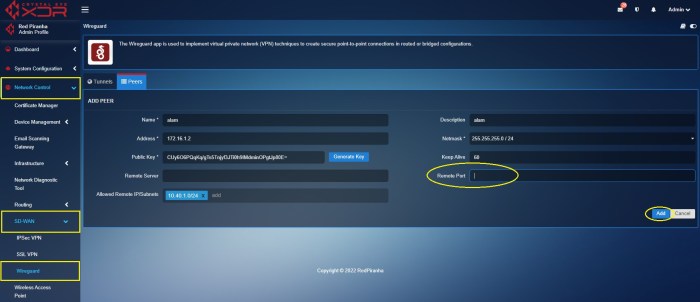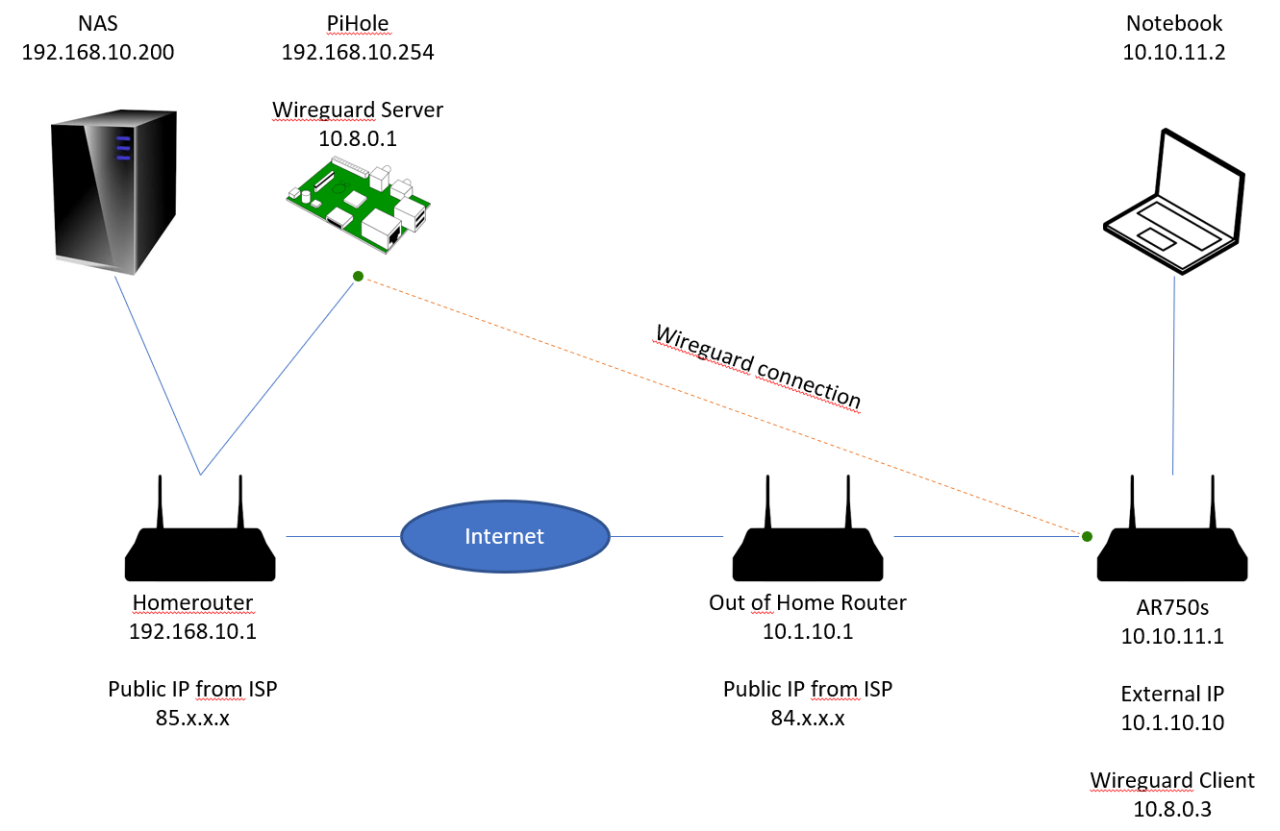ssh.sshslowdns.com – In the realm of secure networking, WireGuard emerges as a formidable player, offering lightning-fast connectivity and unparalleled encryption. Split tunneling, a game-changing feature of WireGuard, empowers users with granular control over their network traffic, enabling seamless integration between secure and unencrypted connections.
Embark on this journey as we delve into the intricacies of split tunneling with WireGuard, exploring its benefits, implementation, and best practices.
With split tunneling, you can selectively route specific traffic through the secure WireGuard tunnel while allowing other traffic to flow directly through your regular internet connection. This unparalleled flexibility opens up a world of possibilities, from accessing sensitive corporate resources while browsing the web securely to bypassing geo-restrictions while maintaining local network access.
Introduction to Split Tunneling WireGuard
Split tunneling is a networking technique that allows you to route specific traffic through a virtual private network (VPN) while other traffic is routed through your regular internet connection. This can be useful for accessing resources on a private network while still being able to access the internet at large.
WireGuard is a modern VPN protocol that is known for its speed, security, and ease of use. Split tunneling is supported in WireGuard, making it a good choice for users who want to take advantage of the benefits of both split tunneling and WireGuard.
Benefits of Using Split Tunneling with WireGuard
- Improved performance: By routing only specific traffic through the VPN, split tunneling can help to improve the performance of your internet connection. This is because the VPN will not be encrypting and decrypting all of your traffic, which can save bandwidth and reduce latency.
- Increased security: Split tunneling can help to increase the security of your network by isolating your VPN traffic from your regular internet traffic. This can help to prevent attackers from accessing your private network resources.
- Greater flexibility: Split tunneling gives you the flexibility to choose which traffic is routed through the VPN and which traffic is not. This can be useful for accessing resources on a private network while still being able to access the internet at large.
Configuring Split Tunneling with WireGuard
Split tunneling with WireGuard allows you to selectively route traffic through the VPN tunnel while keeping other traffic on your local network. This is useful for accessing local resources while still benefiting from the security and privacy of a VPN connection.To
set up split tunneling with WireGuard, you will need to modify the configuration files on both the client and server. On the client side, you will need to add a rule to the AllowedIPs section of the configuration file. This rule should specify the IP address or subnet of the local network that you want to exclude from the VPN tunnel.For
example, on a Linux client, you would add the following line to the AllowedIPs section of the WireGuard configuration file:“`AllowedIPs = 192.168.1.0/24“`This rule would exclude all traffic from the 192.168.1.0/24 subnet from the VPN tunnel.On the server side, you will need to add a route to the routing table that points the local network traffic to the client’s IP address.
This route should use the same IP address or subnet that you specified in the AllowedIPs section of the client configuration file.For example, on a Linux server, you would add the following route to the routing table:“`ip route add 192.168.1.0/24 via 10.0.0.1“`This
route would direct all traffic from the 192.168.1.0/24 subnet to the client’s IP address, 10.0.0.1.Once you have made these changes, you should be able to connect to the VPN and access the local network resources without having to route all of your traffic through the VPN tunnel.
Security Considerations for Split Tunneling

Split tunneling introduces potential security risks that must be addressed to ensure the protection of sensitive data and systems.
One of the primary concerns with split tunneling is the potential for data leakage. By allowing specific traffic to bypass the VPN tunnel, there is a risk that sensitive data could be intercepted or accessed by unauthorized parties.
Mitigating Security Risks
To mitigate these risks, it is essential to implement robust security measures:
- Strong Encryption: Use strong encryption algorithms to protect data transmitted through the VPN tunnel and the untunneled network.
- Firewall Rules: Implement firewall rules to restrict access to sensitive resources and services only through the VPN tunnel.
- Access Control: Enforce strict access controls to limit who can access the VPN and configure split tunneling rules.
- Regular Security Audits: Conduct regular security audits to identify and address any potential vulnerabilities or misconfigurations.
Performance Implications of Split Tunneling

Split tunneling can impact network performance in several ways. When using split tunneling, only specific traffic is routed through the VPN tunnel, while the rest goes through the local network. This can lead to increased latency for traffic that is not tunneled, as it must travel a longer path to reach its destination.
Optimizing Performance
To optimize performance while using split tunneling, consider the following tips:
-
- -*Identify critical traffic
Determine which applications and services require the added security of the VPN tunnel. Route only this traffic through the VPN, while allowing other traffic to go through the local network.
- -*Identify critical traffic
-*Use a high-speed VPN connection
A faster VPN connection will reduce latency and improve overall performance. Consider using a VPN provider that offers high-bandwidth connections.
-*Configure the VPN tunnel properly
Ensure that the VPN tunnel is configured correctly, with appropriate settings for encryption and authentication. Improper configuration can lead to performance issues.
-*Monitor VPN performance
Regularly monitor VPN performance to identify any bottlenecks or issues that may impact network performance.
-*Consider hardware acceleration
If possible, use a VPN client that supports hardware acceleration. This can improve performance by offloading encryption and decryption tasks from the CPU to dedicated hardware.
Troubleshooting Split Tunneling Issues
Implementing split tunneling may encounter challenges that require troubleshooting.
Here are common issues and their potential solutions:
Incorrect Network Configuration
Verify the network configuration settings, including IP addresses, subnet masks, and gateway settings, to ensure they are correct for both the local network and the remote VPN.
Firewall Interference
Check if the firewall is blocking the traffic from the split-tunneled applications. Configure the firewall to allow traffic from these applications to the desired destinations.
Routing Issues
Ensure that the routing table is configured correctly to direct traffic from the split-tunneled applications through the VPN interface. Check if there are any conflicting routing entries or misconfigurations.
DNS Resolution Problems
Verify that the DNS settings are configured correctly to resolve domain names to the appropriate IP addresses. Consider using a custom DNS server or split DNS configuration for optimal performance.
Application Compatibility
Some applications may not be compatible with split tunneling. Check the documentation or support forums of the application to determine if it supports split tunneling and how to configure it accordingly.
Use Cases for Split Tunneling
Split tunneling offers several advantages in various scenarios, allowing users to selectively route specific traffic through a VPN while maintaining direct internet access for other traffic.
Some notable use cases for split tunneling include:
Remote Access
- Employees working remotely can access company resources securely through a VPN while maintaining access to local devices and services.
- Remote desktop connections can be secured through a VPN, while allowing users to interact with their local desktop environment without latency issues.
Security and Compliance
- Organizations can restrict access to sensitive data or applications to specific devices or networks through split tunneling.
- Split tunneling can help organizations comply with industry regulations that require specific data to be protected, while allowing other traffic to bypass the VPN.
Performance Optimization
- Split tunneling can improve network performance by routing non-critical traffic directly over the internet, reducing latency and congestion on the VPN.
- Users can access local resources and services with higher speeds, while still enjoying the security benefits of a VPN for sensitive data.
Comparison of Split Tunneling Methods
Various methods exist for implementing split tunneling with WireGuard. Each method offers distinct advantages and disadvantages, depending on the specific requirements and constraints of the deployment.
Rule-Based Split Tunneling
Rule-based split tunneling allows the administrator to define specific rules that determine which traffic is routed through the VPN tunnel and which is not. This method provides granular control over the split tunneling behavior, enabling the administrator to tailor the configuration to meet specific needs.
Advantages:
- Granular control over traffic routing
- Flexibility to adapt to changing requirements
Disadvantages:
- Can be complex to configure and manage
- May not be suitable for large-scale deployments
Tag-Based Split Tunneling
Tag-based split tunneling assigns tags to network interfaces or devices, and then uses these tags to determine which traffic is routed through the VPN tunnel. This method simplifies the configuration process compared to rule-based split tunneling, as it does not require the administrator to define complex rules.
Advantages:
- Simplified configuration and management
- Suitable for large-scale deployments
Disadvantages:
- Less granular control over traffic routing
- May not be suitable for complex deployments with specific routing requirements
Default Gateway Split Tunneling
Default gateway split tunneling routes all traffic through the VPN tunnel except for traffic destined for specific subnets or hosts. This method is simple to configure and manage, but it offers less flexibility and control compared to rule-based or tag-based split tunneling.
Advantages:
- Simple configuration and management
- Suitable for small-scale deployments
Disadvantages:
- Limited flexibility and control over traffic routing
- May not be suitable for complex deployments with specific routing requirements
Advanced Split Tunneling Techniques
Explore advanced techniques for customizing split tunneling configurations and discuss the use of routing tables and firewalls.
Customizing Routing Tables
Advanced split tunneling techniques allow for fine-grained control over which traffic is routed through the VPN tunnel. One approach is to modify the routing table to specify specific destinations or subnets that should be routed through the tunnel.
For example, to route all traffic to a specific website (example.com) through the VPN tunnel, you can add a static route to the routing table:
route add
-net 192.0.2.0/24 via 10.0.0.1 Where 192.0.2.0/24 is the subnet of the website and 10.0.0.1 is the IP address of the VPN gateway.
Utilizing Firewalls
Firewalls can also be used to implement split tunneling. By creating firewall rules that block traffic to specific destinations or subnets, you can force that traffic to be routed through the VPN tunnel.
For example, to block all traffic to a specific website (example.com) from going through the VPN tunnel, you can create a firewall rule:
iptables
-A OUTPUT
-d 192.0.2.0/24
-j DROP Where 192.0.2.0/24 is the subnet of the website.
Best Practices for Managing Split Tunneling

Managing split tunneling configurations effectively requires a comprehensive approach that includes careful planning, monitoring, and maintenance strategies.
Monitoring and Maintenance
Establishing a robust monitoring system is crucial for detecting any configuration changes or security breaches. Regular audits and vulnerability assessments should be conducted to ensure the system remains secure. Additionally, regular maintenance tasks such as software updates and patch installations are essential to keep the system up-to-date and secure.
Centralized Management
Centralized management tools can simplify the task of managing multiple split tunneling configurations. These tools provide a single interface for managing all configurations, making it easier to enforce policies and track changes.
Automation
Automation can help streamline the management process, reducing the risk of human error and ensuring consistency. Automated scripts can be used to perform tasks such as deploying configurations, monitoring performance, and generating reports.
Documentation
Proper documentation is essential for understanding and managing split tunneling configurations. Documentation should include detailed information about the configuration, including the rationale for using split tunneling, the specific rules applied, and any troubleshooting steps taken.
Training and Education
Providing training and education to administrators responsible for managing split tunneling configurations is essential. This training should cover the principles of split tunneling, best practices for configuration and management, and troubleshooting techniques.
Conclusion
Split tunneling with WireGuard offers numerous benefits, including enhanced security, improved performance, and increased flexibility. It allows users to selectively route specific traffic through the VPN while allowing other traffic to bypass it. This can be particularly useful for applications that require a secure connection but do not benefit from being routed through the VPN, such as accessing local network resources or streaming media.
Despite its advantages, split tunneling also comes with some considerations. One potential drawback is the increased complexity of managing and configuring split tunneling rules. Additionally, split tunneling can introduce security risks if not implemented properly. It is essential to carefully consider the security implications and configure split tunneling rules accordingly.
Recommendations for Further Research and Development
There are several areas where further research and development can enhance split tunneling with WireGuard. One promising area is exploring the use of machine learning and artificial intelligence to automate the creation and management of split tunneling rules. This could significantly simplify the process and make split tunneling more accessible to a broader range of users.
Another area of research is investigating new methods to improve the performance of split tunneling. This could involve developing more efficient routing algorithms or implementing hardware-accelerated solutions. By improving performance, split tunneling can become more practical for use in high-bandwidth applications.
Finally, further research is needed to address the security implications of split tunneling. This could include developing new techniques to detect and mitigate security risks, as well as exploring the use of formal verification techniques to ensure the correctness of split tunneling implementations.